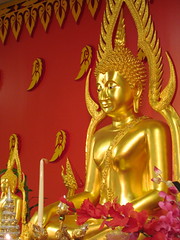This is part 6 of Suriya "Nuk" Chitchulanon's journal describing his Buddhist ordination ritual and subsequent monkhood.
---
Some Challenges to Overcome
Prior my decision to become a monk, I was fully aware that I must live under 227 precepts and should follow monk’s rules and practice. I must give up the things I enjoyed in my laypersons lifestyle such as getting up late, watching American Idol or Hells Kitchen, going to the coffee shop, sitting on the couch, and sipping a dark mocha latte, partying and drinking Martini, and going to bed very late, etc. Those were obstacles that I need to overcome once I got use to and learned the true meaning behind the precepts.
One of the most challenging monastic lifestyle changes was to get up early at 4:30am to do the morning chanting. Usually if I do not have any appointment or travel plans or work, I never get up before 7:00am. However, for my 7-days as a monk, I could get up as early at 4:00am without any problem (of course, I went to bed at 9:30pm on the previous night). From what I experience in getting up early, I found that it was very refreshing. It was refreshing from the fresh air I breathed. My soul was peaceful and serene from the cool quiet morning. I could hear nothing but the creaking sound as I walked. Only a cup of warm herbal tea or warm water could wake me up all morning until the afternoon.
Another challenge as a monk was not to have dinner. This is according to one of the 227 precepts - rules of conduct. I was to abstain from eating at the wrong time (the right time was eating once, after sunrise, and again before noon). It was strange that I did not get hungry at night simply because I drank several glasses of warm water, tea, cider, chocolate malt, etc. There was also no hard exercise after sunset.
Dressing in robes was quite difficult for me. I spent about 15-30 minutes to dress myself prior chanting, breakfast, and lunch time. I kept trying again and again to tighten my robes and I seemed to have either too much robe left over or not enough. Several times I was sweating due to poorly fitted robes. I felt that I looked like a pear mascot. Let me explain briefly about how to put the monk robes on. The monk's wardrobe consists of an outer robe civara (Jivorn) and an under robe antaravassaka (Sabong) that is worn around the waist, covering the navel and falling to just below the knees. The Jivorn is large and is generally wrapped around the body with the two ends rolled together. The roll is taken over the left shoulder and under the left arm so that its end can be held in the left hand or pressed firmly between the arm and the body. Under Jivorn, on the top part of the body is worn a sort of sleeveless one-shouldered waistcoat (Ungsa) which is joined together on the left side by tying tags. The Sabong is held up by a fold and a tuck and a cord belt. For formal religious services inside he monastery, the monks also wears an additional robe (Sanghati) which is folded in a very particular way into a long rectangle and hung over the left shoulder.
Continued...
Part 1, 2, 3, 4, 5, 6, conclusion.

No comments:
Post a Comment